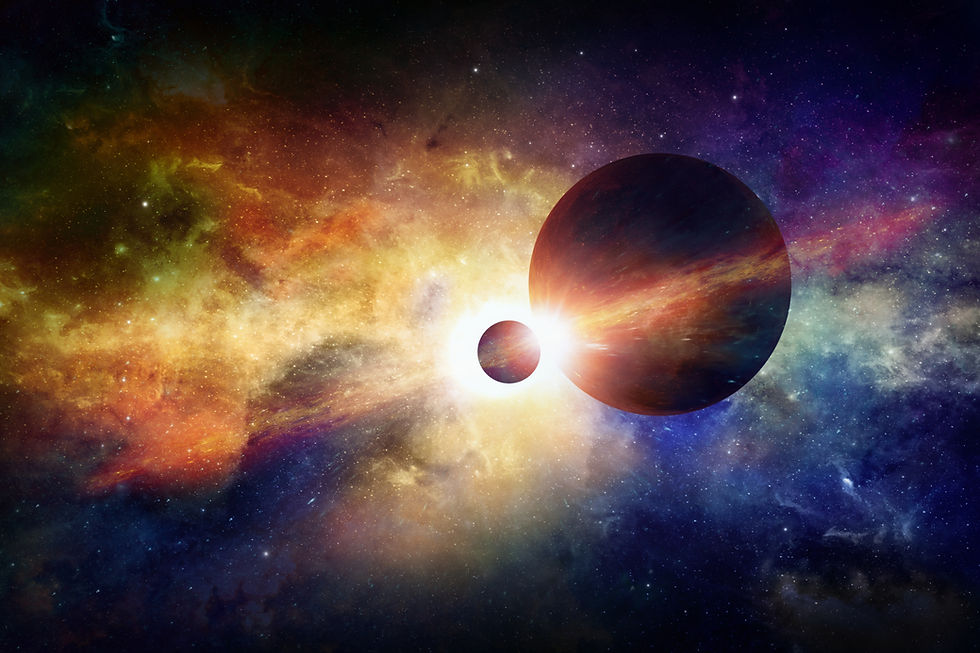Rahu and Ketu: Mystical Shadows That Shape Our Lives
- Serene Prana Ayurveda
- Jan 20
- 3 min read

In the world of astrology, few things are as fascinating and mysterious as Rahu and Ketu. They’re not actual planets but shadowy points in the sky—where the Sun and Moon’s paths cross. And yet, their impact on our lives can be immense. These two points, often called the North Node (Rahu) and the South Node (Ketu), hold the key to some of life’s biggest lessons.
The Story of Rahu and Ketu
According to ancient Vedic mythology, Rahu and Ketu were once part of a single serpent. During the great cosmic event known as the Samudra Manthan, the gods and demons churned the ocean of milk to find the nectar of immortality. When the nectar was finally discovered, Rahu—then a demon—disguised himself and tried to drink it. But the Sun and Moon spotted his deception and alerted Lord Vishnu, who swiftly severed the serpent’s head with his discus.
The head became Rahu, always hungry and chasing after what it can never fully hold. The tail became Ketu, detached and looking for spiritual liberation. Together, they symbolize the eternal push and pull between our material desires and our spiritual growth.
Rahu: The King of Illusions
Rahu is like a mirage in the desert. It creates illusions that tempt and mesmerize us, making us chase things we believe will bring happiness. Fame, power, wealth, success—Rahu rules them all. It’s the reason we might find ourselves obsessed with a new goal, thinking, “If only I had this, my life would be perfect.”
But Rahu’s gift is also its greatest lesson. Once we achieve what we thought we wanted, we often realize it doesn’t satisfy us in the way we imagined. Rahu teaches us that life’s pleasures are fleeting, and the real journey is understanding what truly matters.
Ketu: The Master of Detachment
Where Rahu is all about grabbing and holding on, Ketu is about letting go. Ketu represents the part of us that feels like we’ve “been there, done that.” It’s tied to our past, our karmic baggage, and the things we’ve already mastered in previous lifetimes.
Ketu often makes us feel disconnected, restless, or even empty. But this isn’t punishment—it’s an invitation. Ketu pushes us to look inward, to seek answers in spirituality, meditation, and self-discovery. While Rahu keeps us chasing the world, Ketu reminds us that the real treasure lies within.
Rahu and Ketu: The Balancing Act
Life often feels like a tug-of-war between Rahu and Ketu. On one side, Rahu urges us to embrace the material world—its ambitions, temptations, and drama. On the other, Ketu nudges us toward spiritual growth, asking us to release attachments and focus on higher truths.
This isn’t about choosing one over the other. The magic happens when we learn to balance both energies. Rahu teaches us to engage with the world, while Ketu ensures we don’t lose ourselves in it.
Lessons from Rahu and Ketu
Rahu and Ketu aren’t here to punish or scare us. They’re here to help us grow. Their lessons might not always be easy, but they’re always meaningful. Rahu shows us the illusions we’re trapped in, while Ketu shows us the truths we might be avoiding. Together, they guide us toward a more authentic, meaningful life.
So, the next time life feels chaotic or confusing, remember Rahu and Ketu. They’re not just shadows in the sky; they’re mirrors, reflecting the parts of us that need attention. Embrace their energy and let them teach you what you’re really here to learn.
Life’s greatest lessons often come wrapped in mystery—and that’s the gift of Rahu and Ketu.



Comentários